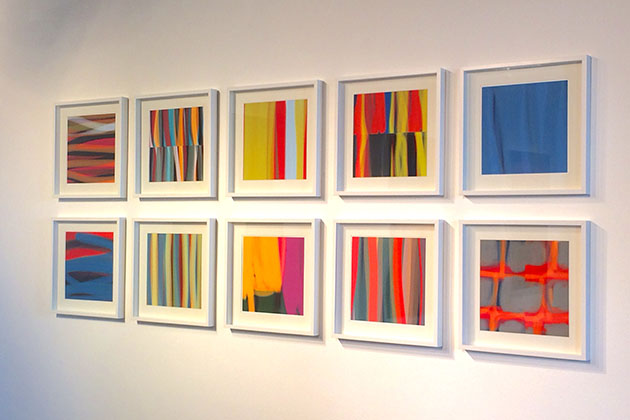
When Olu Oguibe stood in line in Los Angeles in April 2010 to buy Apple’s latest product, the iPad, he was curious about how he could use it to create art.
“I was drawn to the apps that had to do with sketching and doodling,” says Oguibe, professor of art and art history in the School of Fine Arts. “Originally it didn’t come with much. They had a rudimentary app, which I didn’t find very amicable to the kind of thing I had in mind. Just playing around doing sketches and drawings, sharing them on Facebook, it developed from there.”

An artist who has worked in various media but primarily painting, Oguibe settled on the Sketchbook app used by many designers and artists to spend more time creating original art using the iPad. An exhibition of abstract prints from his iPad work created in 2010 is on display at Real Art Ways in Hartford through July 6.
Oguibe, a writer and former associate director of UConn’s Institute for Africana Studies, says that as he created more art, he began to think more about how to exhibit the work. A friend who is also a painter suggested printing the works on canvas.
“Being a painter, my interest went in that direction,” he says. “I hadn’t thought about it. … The excitement was around the painterliness of it all. At the end of the day, once they manifest in this form, they are prints. It’s very fascinating trying to look at all the different aspects. It’s printmaking but there’s an element of painting.”
Oguibe says that owing to the file size of the original iPad creations, it was only possible to print small versions of his art, approximately 5 by 7 inches, generally the type of photo print that might be obtained from any smart phone or mobile device. Working with a friend in New York, he located a commercial printer who could print out the images in a large format on canvas after transferring them to a computer and scaling them to size.

The Real Art Ways exhibition contains five large canvases approximately 4 by 6 feet in size covering two walls in the gallery, and another 10 square works hung in two rows on a single wall. Oguibe – whose work has been exhibited in museums, galleries, and other major venues around the world – uses primarily bright colors of vertical strokes, with a few horizontal strokes. With some seemingly out-of-focus edges along some color strokes, the prints resemble images created in colorful charcoals.
“That’s just me. It’s very traditional in that sense,” he says of the prints, which strongly resemble his painting style, even as he was using his index finger instead of a brush. “My goal was not to reinvent the wheel. What I want to do is use it to make pretty much what I would normally make or lead into another direction.”
Creating broad strokes on the iPad takes just a few seconds, he says demonstrating on the tablet he holds in his hand at the Hartford gallery. Pointing to one of the large prints highlighted by a large blue swath across the side, Oguibe says to fill the same space working on canvas with a brush “would take quite a while.”
Exhibitions of art created using iPads, iPhones, and other digital technology have not been widespread. Oguibe says most art created using such technology is primarily shared online or by email with friends, with only an occasional print being made.
“So far I think that’s been the limit of people’s imagination,” he says. “It was interesting to see where it could be taken.”
Oguibe notes that children were quickly attracted to the printed canvases at the Hartford exhibition: “Kids love them. I find it fascinating how they go right into the images … The works actually pull you in. There is an element of depth that one would not normally expect of digital work.”
Digital technology in other creative arts is not unusual – animation, film graphics, and music have been using computers for several years – but the use of this technology in art is most familiar in design, such as photo manipulation/illustration, graphic arts, and other commercial applications.
A former literary and theater critic, Oguibe continues to write scholarly articles on contemporary art theory and criticism and postcolonial and new information technology, in addition to his teaching and art. With such a busy schedule, he says the portability of the iPad allows him to still create new art when he cannot work in his studio, and he hopes this will help artists to expand the possibilities of digital art creation.
“Mobile technology frees you up to take your studio practice with you wherever you are,” he says. “I’m working with it and looking at how it informs my normal traditional painting. My sense is that mobile devices can do for painters, printmakers, or visual artists in general what the oil paint tube did for painters in the 19th century , freeing them up to work in plein aire – working on location outdoors – and giving rise to Impressionism. That’s something I’d like to pass on to my students as well.”



